The Burmese Python is one of the largest snakes in the world, but can also live in your house too! The question is, should they and are they a good snake for beginners?
Typically a gentle giant, this snake is relatively docile when it comes to human interaction. He may be large, but he is very common as a pet and relatively inexpensive. He most commonly has a brown, leopard-like color pattern, however, he may also have an albino appearance too!
These snakes are naturally from southeast Asia, but they are now an invasive species to southern Florida, where the warm climate allows them to thrive.
They require a consistency, but this routine is manageable if this is really the one for you!
Burmese Pythons require an experienced owner who is committed to proactive husbandry and is fully prepared to deal with its size. If you think you are ready, keep reading to understand how to properly handle, feed, and care for this Python.
Are Burmese Pythons Good Pets?

The Burmese Python is among one of the largest snakes to slither on this Earth. They are native to southeast Asia, and span across Thailand, Cambodia, Laos, Vietnam, and southeastern China.
First formally identified by European naturalist Heinrich Kuhl in 1820. Kuhl described the snake as Python bivittatus, and it wasn’t until 1910 when this snake was actually recognized as a subspecies of Python molurus.
Since 1910 it has been classified as Python molurus bivittatus, and the only other subspecies in this family is known as the Indian Python.
This large Python can grow to a giant 21 feet long and weigh nearly 200 pounds.
Commonly found with light and dark patterns of leopard-like spots, although recently albinos and banana-yellow Burmese Pythons have been discovered.
This snake is unique in the reptile-world for how infrequently they eat. They may eat once every several weeks or even months, and the meals they consume may be as big as they are themselves. After eating, they very nearly double in size. Because of this, they’ve been a vivid subject of interest to researchers who are interested in the extreme adaptations of snakes.
In terms of husbandry, they need heating and lighting, as do most snakes and require a very clean enclosure to prevent illness.
| Summary Table | |
|---|---|
| Common Names | Burmese Python |
| Scientific Name | Python molurus bivittatus |
| Adult Size | 15-21ft |
| Adult Weight | 40-200lb |
| Lifespan | Up to 30 years |
| Diet | Small mammals |
| Tank Size | 5 ft x 5 ft x 10 ft (adults) |
| Temperature | Humidity 60% Temperatures between 80-86℉ |
| Popular Alternatives | Indian Python |
Burmese Python Care Sheet
Naturally they are found in the tropical southeast of Asia, and their habitat consists of tropical lowlands, mangrove forest, rainforest, wet grasslands, and coastal plains. It is this natural environment that has allowed the species to thrive in Everglades National Park in Florida.
When caring for a Burmese Python in captivity, you will need to remember they are ground dwellers, so their enclosure should be much longer than it is tall and will need a warm, humid environment (just like their wild one).
Housing Requirements
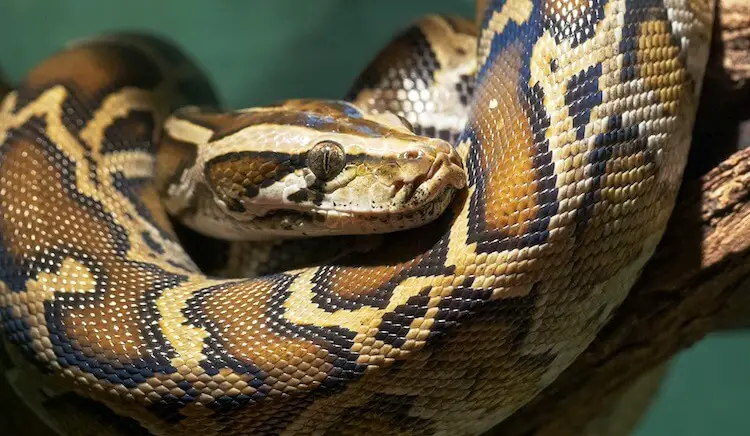
Baby Burmese Pythons can be housed individually in 20-gallon plastic containers. As they grow, they will need to be moved to larger enclosures (they will grow fast):
- A 9-month python will need a container of at least 3 ft x 1.5ft x 1.5ft
- Adult pythons will need an enclosure that is about 5ft x 5ft x 10ft
For both enclosures, at least one side of their tank should be glass and a solid enclosure-top is a good idea to prevent potential escape.
Babies may need a soaking dish, but adult snakes will not use a soaking dish as often. Regardless of soaking or not, your python should always have access to fresh drinking water. Also, be sure to provide logs and branches for your snake to give them places to hide.
Heating and Lighting
Burmese Pythons need a tank that is between 80℉-86℉ with a high humidity of around 60%. The tank should have 14 hours of light and 10 hours of darkness.
Under tank heating may work well for younger snakes, but adults should be warmed using ceramic or infrared bulbs. They also need a basking area of around 90℉.
Some owners choose to give them a folded blanket that they can hide in to feel warmer. Fluorescence lighting can also be used as an addition to the heated bulb.
Substrate
Soil and artificial grass are the best substrate you can use when building a perfect habitat. Both substrates are difficult to maintain, so when you consider the convenience for the caretaker, many choose paper towels or newspaper for their quick and easy replacement.
A benefit of paper towels is they display bacterial growth much more easily than grass or soil, and they are much easier to clean (especially in a large tank).
Burmese Pythons are prone to bacterial respiratory infections, consistent husbandry is essential in helping them stay healthy. They need a clean, bacteria-free environment.
| Tank Tips | |
|---|---|
| Tank Type | Glass |
| Lighting | Fluorescence lighting |
| Heating | Ceramic Heater |
| Best Substrate | Soil |
What To Feed A Burmese Python?
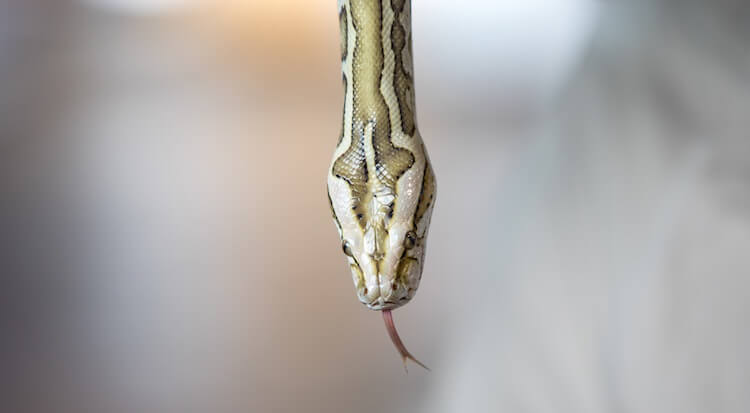
The diet and metabolism of this snake has piqued the interest of many researchers.
They can expand their jaws to accommodate a meal that may even be as big as the snake itself. They’ve been known to eat small and large mammals alike, and have even proven to strangle and swallow deer and alligators whole.
In the wild Burmese Pythons often eat deer, monitor lizards, large rodents, and ground-dwelling birds.
Like many snakes, they are a sit-and-wait type of predator. They wait for their prey rather than actively searching for it. He will only eat once every several weeks or even months.
The little energy they spend foraging is made up for how much energy they spend while digesting their food in their stomach. This process begins when they catch their prey by lunging and sinking their fangs into it. They kill their prey by coiling around it and crushing and suffocating it. Then the python expands its jaws to swallow their meal whole, head first.
The eating process observed in the wild should be replicated in captivity. Your Burmese python should eat every other week (if not more infrequently) and their food should be about the same width as themselves:
- Babies they should eat pinky mice
- Juveniles they should be eating several mice, large rats, or small rabbits
- Adults can eat a large rabbit or a whole chicken
Their food should be freshly thawed and generally 30%-50% of the snake’s own bodyweight.
Once your Burmese Python has consumed his meal, do not be alarmed if he suddenly looks much bigger! After eating a meal, their small intestine, liver, heart, pancreas, and kidneys all expand tremendously in size (a trait unique to just this snake).
| Diet Summary | |
|---|---|
| Fruits | 0% of diet |
| Insects | 0% of diet |
| Meat | 100% of diet Mice, rats, rabbits, and chicken |
Common Health Issues
Like most reptiles, Burmese Pythons are healthy in captivity. Providing they have good husbandry, some can live up to 30 years, however, they are prone to a couple conditions. Some exhibit various cardiovascular lesions and diseases. Symptoms include listlessness, swelling near the heart and mouth, and a bluish-color in their mouth.
Burmese Pythons are also susceptible to lower respiratory infections which may cause bronchitis and pneumonia.
If your python is wheezing, or they have nasal discharge, this may be indicative of respiratory distress. It is mostly caused by poor-husbandry, particularly a dirty enclosure or cold temperatures in their tank. Cold temperatures can even cause death if it gets too low.
Another issue that snakes are prone to is egg retention or oviductal rupture during delivery. Detecting this will require a veterinarian as you must be able to palpate and feel if an egg is stuck.
If you suspect any of these illnesses with your Burmese Python, it is best to consult your veterinarian, where they could get an ultrasound or x-ray, if necessary.
Because of how infrequently they eat, they usually have less of a problem with being overweight than other species. Nonetheless, you should still monitor their size, especially during the rapid growth during the first years of their life.
Tank Cleaning
To keep your Python healthy make sure to maintain correct temperature, daylight hours, and a good nesting place; preventing these health problems is easy with good husbandry and hygiene.
Make sure you keep the enclosure clean and maintain the proper temperature (between 80-86℉). Spot clean the cage and provide fresh water daily. Don’t let the large size of the tank keep you from cleaning!
Burmese Pythons typically defecate 8-14 days after a meal, their feces should be brown and relatively solid. You should use this as an opportunity to undertake a deeper-clean and replace the substrate.
| Signs They Are Healthy | Sickness Symptoms |
|---|---|
| Swallowing prey whole | Not eating when given food |
| Breathing normally | Wheezing or nasal discharge |
| Increasing in size after eating | Abnormal swelling not related to eating |
Are Burmese Pythons Aggressive?
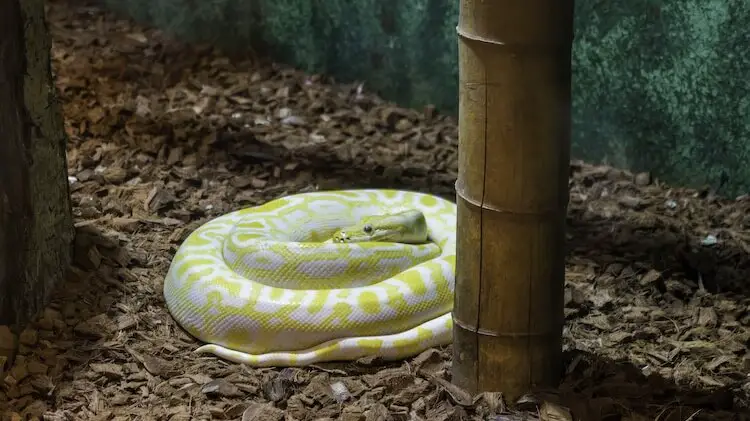
In the wild, they are solitary and inactive. They do not tend to interact with each other, and mating season is the only time you will find them in pairs.
Cohabitation is more of a complex topic when it comes to Burmese Python. Housing two snakes together also increases the overall stress levels If it’s necessary, then yes it is possible, however, we would recommend against it if you can avoid this.
If you must house two together for any reason, they must both be healthy, adult pythons. Because Pythons can become aggressive towards their prey when feeding, it can be difficult to feed two pythons together. Some have been known to resort to cannibalism if they fight over food.
They do not have an obvious way to communicate with each other. They are good swimmers and live near water, but they are otherwise rather inactive. They do not actively forage, and most of their energy is actually spent on digesting.
In captivity, they will be similarly inactive. Most commonly they may bask or hide in logs or branches provided.
Handling Advice
When it comes to handling, they are docile creatures and rarely strike their owner. Burmese Pythons are not venomous.
Before and after handling any reptile, you should always wash your hands. This helps to maintain proper hygiene for both you and your pet. They should be handled frequently from a young age so that they get used to being held. This will help you avoid an unmanageable, 100-pound animal in the future.
These large snakes absolutely need proper handling. When he grows to an adult size, he must be handled by at least two people. These snakes are too long and too heavy to be held by one person. He should not be handled during feeding or while he is digesting food, which may last several days.
Many people often let them go, or they end up euthanized because owners could not handle having such a large animal. This is why the python has become an invasive species in Florida.
Appearance
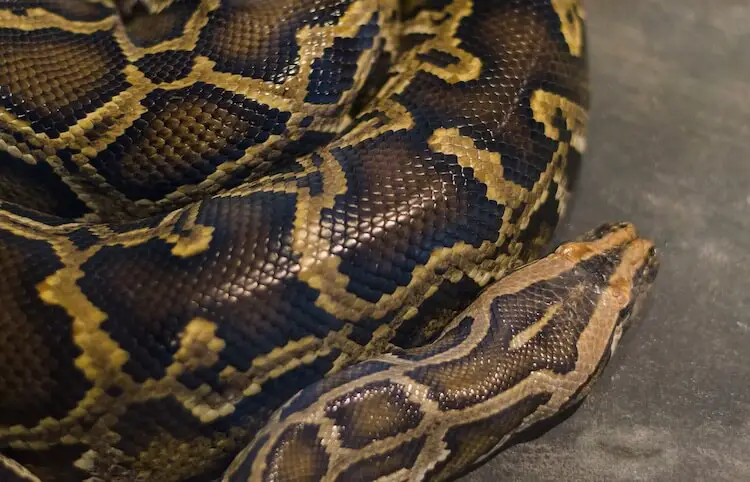
The Burmese Python is a subspecies of Python molurus, and it has very little variation when it comes to different types. One of the few recognizable differences is their more rectangular shaped head when compared with rattlesnakes, cottonmouths, and water snakes.
What sets the Burmese Python apart from other pet snakes is its remarkable size! The only real difference between sexes is that females tend to be bigger than males.
These pythons are light-colored with dark brown blotches. Their blotches are bordered in black, and the pythons’ bellies are always pale. The tops of their head are dark with light stripes on either side of their head, starting from the temporal region. Albino pythons have the same patterns, except they come with white and banana-yellow colors instead of shades of brown.
How Big Do Burmese Pythons Get?
The size of the Burmese Python is their most famous trait. Adult females on average are about 21 feet long and weigh between 80 to 200 pounds. Males are about 15 feet long and weigh 40-110 pounds.
| Age | Size | Weight |
|---|---|---|
| Hatchling | 10-30 inches | 100-115 grams |
| 3 months | 16-40 inches | 190-650 grams |
| 9 months | 40-50 inches | 570-780 grams |
Females reach sexual maturity at about 18 months. Any snake weighing more than 200 pounds and is several feet longer than 21 feet is considered very large.
Buying a Burmese Python
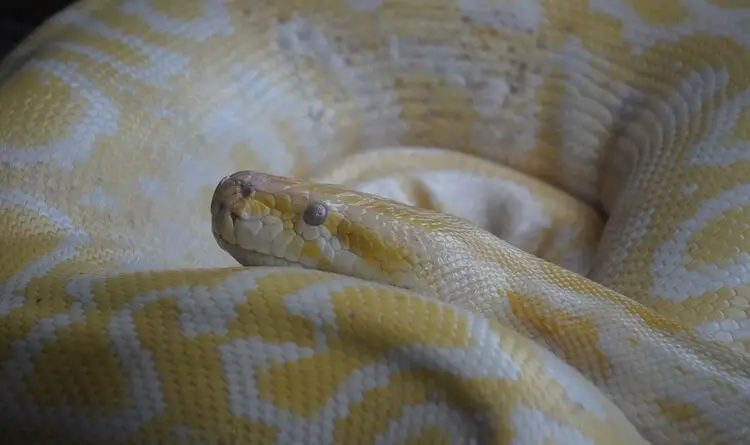
They are considered to be near-threatened in their native home as they are routinely hunted and killed for their skin.
During the mid 90s and 2006 in the US nearly 100 thousand Burmese Pythons were imported. Whilst considered an exotic reptile, they are still very abundantly bred in the pet trade and well-established in southern Florida.
To avoid any more interference with their native home, you should purchase your Burmese from someone who has captive-bred the reptile and who has extensive knowledge about handling. The reason this snake is now taking over the Florida Everglades is because many reptile owners were not prepared to handle such a large snake.
How Much Do Burmese Pythons Cost??
They are relatively inexpensive when compared to many pet snakes and will sell for as little as $20 USD. Some pet stores may sell them for between $65-$80.
These are of course some species variations that cost more. The albino coloration being slightly more expensive at $500 USD.
Young Burmese Python
A male will attract a female with tongue flicks. He will lift his head to her dorsal side, and the female may respond with slow body jerks. Courtship takes place when the male mounts the females and forms himself into a c-shape. He then proceeds with sliding movements known as writhing.
Burmese Pythons generally breed between November and March.
They lay eggs 65-120 days after breeding, usually lying between the wide range of 8-107 eggs per clutch. Eggs will then hatch 53-88 days after being laid. Temperature does not affect the sex of the hatchlings.
Care Guide Summary
| Why We Love Them | What Makes Them Difficult |
|---|---|
| Very docile and calm | Care routine requires commitment |
| Popular and inexpensive | Prone to infections |
| Huge size and weight | An unmanageable size for many |
The Burmese Python is a gentle snake which can make a great, albeit large, addition to a home.
Their large cage requires a committed cleaning routine, and although they eat infrequently, they eat large meals that must be provided by their owner.
Reptile owners that were ill-prepared to care for this snake are responsible for the overrun of this species in southern Florida, and someone who is looking into buying a Burmese Python must be 100% confident in their handling and husbandry abilities.
It is possible for a beginner to own one of these snakes, but they must understand that they are committing themselves for possibly the next 30 years.
A snake that is just as docile but is a more manageable size is the popular Ball Python, one which many beginners start with. If you currently have or are thinking about getting a Burmese Python do let us know below.

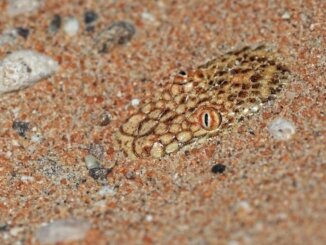
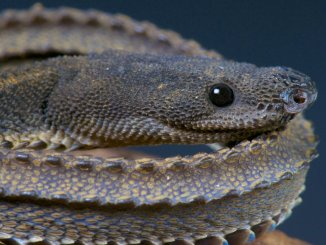
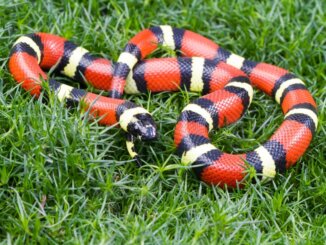

Ì just recently purchased my first burmese python. She is a 2 month old Albino visual Het Granite.
Congratulations Smokey! Best of luck.
I am trying to find a hatchling to purchase if anyone knows where to get one please let me know. There are a lot of websites I don’t trust and I live in Mississippi
The best thing to do is to find one locally or at lest one you can go see before you make the purchase. It’s the best way to be able to trust someone with such an important choice.
I have a regular Burmese python and have had him since 2003. They only need to eat their weight each year to be healthy. Get a scale, weigh your snake. Weigh his food to determine how often you need to feed. Mine eats jumbo rats. He accepts 2 each feeding. He takes the first and I wait until it disappears in his body and then give him the 2nd. I have done this with live rats in the past, but he only gets pre killed thawed rats now. He has a smaller girth and is quite long. My snake has never not eaten when food has been offered or vomited a meal in his entire life.
After years of wanting one, I finally purchased a Female Albino Burmese Python.
I have a Burmese python I got when she was about 2 foot long. She is a female her name is Bernice, it was my brother’s snake, I got her when he passed. I did handle her all the time up till she was about 7 Foot. I still have her have her in a cage that is 4 x 4 x 8. I have made it to where I can put a separation plate so that way I can clean one side and change her water. She’s about 12 foot right now and I’m guessing she’s about 80-90 pounds. I will have to make her a bigger enclosure. They are a commitment that takes a lot to clean, feed and change water. Hope my experience helps you
The reason they have taken over Florida is because of a research facility that was destroyed releasing their subjects into the wild. From there having no natural predators, they bred and have over taken the area. Although some have released, pet owners were not the problem.
How to know their sexes? I got one and it is more than one year old albino burmese python.
When it comes to distinguishing the gender of your Burmese python there are physical differences to note which are known as sexually dimorphic. The biggest difference comes with their overall size. Females are simply bigger than the males. Females are usually 17-20ft and males are 10-15ft when fully grown. Males also tend to have narrower bodies and proportionately smaller heads. Males usually have longer spurs than females which are remnants of relic legs that the species had long ago. Often the male spurs are actually used in mating to gently tickle a female.
Burmese pythons usually reach reproductive maturity at the age of 4-5years. So your Burmese python is unlikely to be there yet. From a length perspective males tend to be able to reproduce from 7-9ft and females have to be 9ft and over in order to reproduce. The best way to get a definitive answer is to have your vet assess your snake for overall health and then gender and can be confirmed at the same time. If your Burmese python is a female please remember that they are prone to egg retention during delivery and veterinary care is essential for your pet.
I really want a pet snake but I am not sure if I can take care of a Burmese python, it sounded easy at first but after reading this article I realized it would be a lot harder than I thought and I’m not sure if I’m ready for the commitment. I can barely take care of myself how am I supposed to take care of snake that needs this much consistency and care.. I really wanted one tho I just thought it would be easier :-/
Burmese are about as easy as it gets when it comes to snake husbandry, right up there with ball pythons. The only difference is size and housing cost really. Easy to keep humidity and temp levels, very friendly personalities and great eaters. If you can afford a big enclosure to keep one in, go for it! Mine is about five months old and over three feet, he is a sweetheart and has given me less trouble than my ball python. One thing I’ve noticed is they will let you know quickly if their enclosure is too small, lots of nose rubbing and restlessness. Don’t skimp on housing.
Hello
I have a quite unique problem: i have a few ball Pythons and all is fine. A month ago i got myself a burmese albino and she is the problem child. I tryed every single possible food: fresh (live) and frozen: mice, rats, hamsters etc but she just wont eat. Was trying to give her something every other day with the same effect: she just “sniffs” her food and if its frozen she ignores it, and if its alive she wants to SNUGGLE WITH IT EVERY SINGLE TIME. I got her checked up by a vet and she is 101% healthy. About a week ago i left a live Maus for my girl in her Terrarium, but till today Maus is doing fine and my girl snuggles with it from time to time.
I talked with the breeder but he Has no idea what to do.
Any advice? Pls
Do not leave live prey with a snake unsupervised as you can end up with badly damaged snake. I’ve known rats to kill snakes in captivity when the snake wasn’t hungry